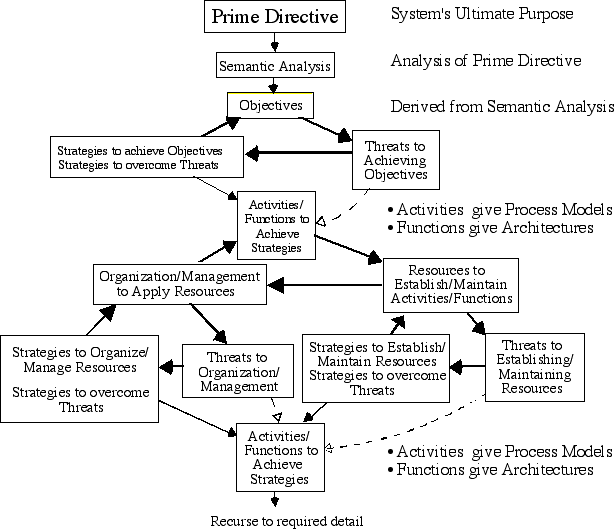Systems Methods - Derek Hitchins
See "Putting Systems to Work," and
" Advanced Systems Thinking, Engineering and Managemen,"
both by the author.

The TRIAD Building System is a powerful method for building purposeful process models and architectures. Outputs are lean, focused, and incorporate risk and threat management. Every item, process, strategy, activity, etc. is generated directly to achieving the Prime Directive. That is why the approach results in such lean, focused solutions. The method also recognizes and seeks to neutralize threats. Expertise may be needed in identifying and predicting threats in particular domains.
As the figure illustrates, The TRIAD Building System generates both Process Models and Architectures. Following sections show how these are achieved respectively.
The TRIAD of the name is a simple device, in which
- an objective is declared,
- Strategies to achieve that objective are proposed
- Strategies to overcome threats to achieving that objective are also proposed.
This simple device is used at intervals throughout the methodology, as shown in the figure.
First, however, comes the Prime Directive, the statement of the ultimate purpose for some system or process. This is a high level statement which encompasses the intended purpose, and which contains only one action verb.
The Prime directive (PD) for the human species is normally taken as:
"to propagate the species"
which requires
- procreation,
- nurturing, and
- social development of the following generation if they are to be able to continue the process.
Our PD drives our social behavior, our instincts, and even governs our physical shape.
However, "to propagate the species" is a PD shared by every living thing on the planet, so it would be a poor discriminator.
Prime Directives - Examples
1. For the UK Air Defence System:- "To neutralize enemy air incursions into UK air space"
2.For a University:- "To advance understanding" (i.e. both of students and, through their own research, of academics, too.)
3. For a family:- "To nurture offspring"
4. For a government:- "To improve the nation's well-being" (though it might seem tha they have a funny way of gong about it, at times.)
The Prime Directive may seem bare: that is intentional, to clarify ultimate purpose.
Semantic analysis is used later to draw out the full richness of the PD's meaning.
Given a Prime Directive, therefore, it is useful to analyse it semantically, to extract precise meaning. Consider the following:
Semantic Analysis of the UK Air Defence Region's Prime Directive
"To neutralize... "To eliminate the threat from....
....enemy.. . ......those declared by government to be hostile who....
...air incursions.. . ... enter by air without permission......
..into the UK ADR". ......into the designated airspace legally defined and internationally
promulgated as sovereign UK airspace"
Implied Means:- Use of U.K. Air Defence assets
Note how the semantic analysis, which elaborates the meaning of the PD, ends up as a single sentence, although it may be long and rather legalistic in expression. Implicit in the Semantic Analysis (SA) are a set of objectives. achieving these objectives will satisfy the purpose expressed in the PD.
So, the TRIAD Building System progressively unravels the essential strucutre of a solution. Having identified objectives, and threats to achieving objectives, etc., the proposed strategies can then be eleborated either into
- sets of activities which must occur for the strategies to be realized, or
- functions which will enqble the strategy/activities to execute.
The outcome of this process, where the product is a set of functions, is shown by example to result in architecture. Functions are grouped according to their relationships into functional blocks, which form the basis of functional architecture.
Where, instead, the output from the TRIAD elaboration is to be in the form of activities, some means may prove necessary to accommodate the potentially large number of activities that can easily ensue. Nor do the many activfities necessarily suggest a natural chronology or sequence. Interpretive Structural Modeling is a useful tool for addressing the issue. One of the ways of using ISM is to arrange entities according to whether A preceded B, B preceded A, or there was no precedence. Undertaking this for a set of activities results in a so-called precedence network of activities, which can then form the basis of a coherent plan.
Examples of the TRIAD Building System at work are given in